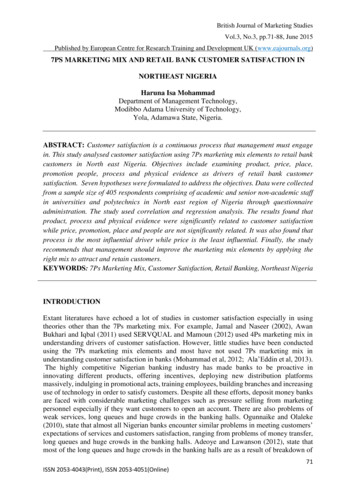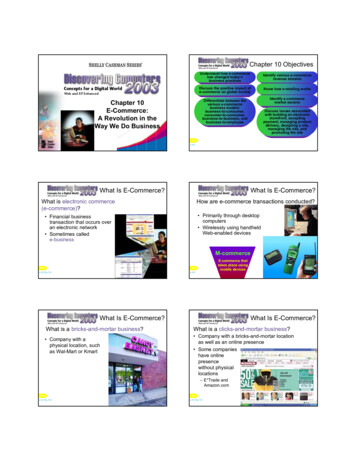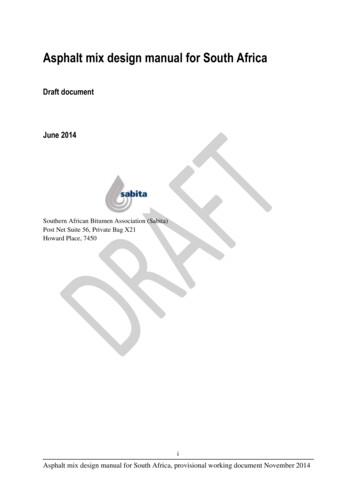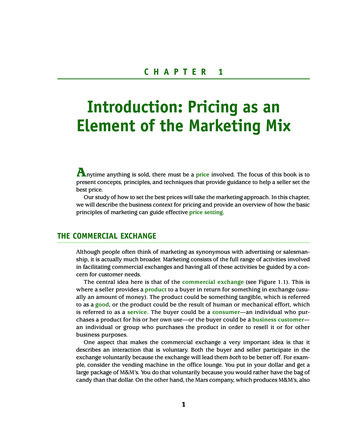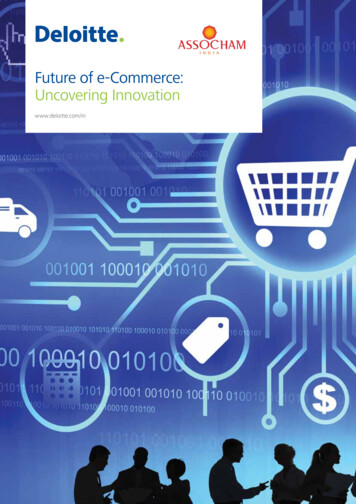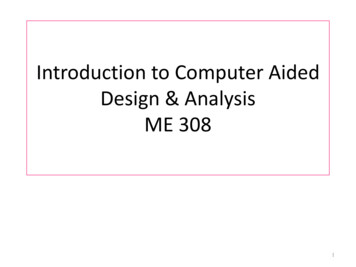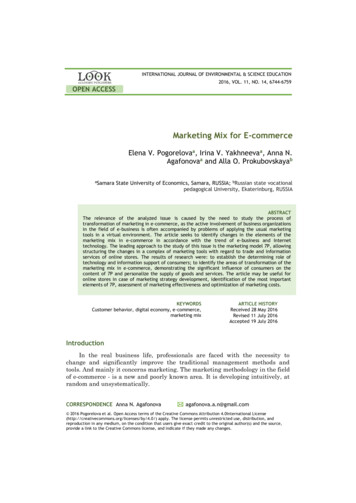
Transcription
INTERNATIONAL JOURNAL OF ENVIRONMENTAL & SCIENCE EDUCATION2016, VOL. 11, NO. 14, 6744-6759OPEN ACCESSMarketing Mix for E-commerceElena V. Pogorelovaa, Irina V. Yakhneevaa, Anna N.Agafonovaa and Alla O. ProkubovskayabaSamaraState University of Economics, Samara, RUSSIA; bRussian state vocationalpedagogical University, Ekaterinburg, RUSSIAABSTRACTThe relevance of the analyzed issue is caused by the need to study the process oftransformation of marketing in e-commerce, as the active involvement of business organizationsin the field of e-business is often accompanied by problems of applying the usual marketingtools in a virtual environment. The article seeks to identify changes in the elements of themarketing mix in e-commerce in accordance with the trend of e-business and Internettechnology. The leading approach to the study of this issue is the marketing model 7P, allowingstructuring the changes in a complex of marketing tools with regard to trade and informationservices of online stores. The results of research were: to establish the determining role oftechnology and information support of consumers; to identify the areas of transformation of themarketing mix in e-commerce, demonstrating the significant influence of consumers on thecontent of 7P and personalize the supply of goods and services. The article may be useful foronline stores in case of marketing strategy development, identification of the most importantelements of 7P, assessment of marketing effectiveness and optimization of marketing costs.KEYWORDSCustomer behavior, digital economy, e-commerce,marketing mixARTICLE HISTORYReceived 28 May 2016Revised 11 July 2016Accepted 19 July 2016IntroductionIn the real business life, professionals are faced with the necessity tochange and significantly improve the traditional management methods andtools. And mainly it concerns marketing. The marketing methodology in the fieldof e-commerce - is a new and poorly known area. It is developing intuitively, atrandom and unsystematically.CORRESPONDENCE Anna N. Agafonovaagafonova.a.n@gmail.com 2016 Pogorelova et al. Open Access terms of the Creative Commons Attribution 4.0International /) apply. The license permits unrestricted use, distribution, andreproduction in any medium, on the condition that users give exact credit to the original author(s) and the source,provide a link to the Creative Commons license, and indicate if they made any changes.
INTERNATIONAL JOURNAL OF ENVIRONMENTAL & SCIENCE EDUCATION6745The authors analyze the theoretical and methodological work on marketingin e-business. K. Kelly (1999), D. Tapscott (1999), D. Chaffey (2007), I.D.Kotlyarov (2012) and other scientists note the trends of stable transformation ofconsumer behavior in the Internet environment. The process of changes in theforms and methods of business is also significant. This led to the realization thatnow almost no attention is paid to the conceptual foundations of the marketingcomponent in e-commerce. This article is devoted to the study of transformationof the classic marketing mix, or the concept of “7P”, offered in 1981 by Americanscientists: B.H. Booms & M.J Bitner (1981) in the virtual environment of ecommerce. E-commerce, the base of which is the trade, is a unique kind ofservice activities and it remains virtually unexplored. These research resultsshow strong growth in e-commerce, both on the world and the Russian markets.According to the agency's East-West Digital News data, the volume of ecommerce market in Russia reached 650 billion rubles in 2015. In ruble terms,the market grew by 16% compared to 2014, in dollar terms - fell by 28%. In2015, the Russians made 160 million purchases on the domestic market; ecommerce is 10% more than the year before (Lopsulin, 2016). The authors setthe goals and objectives, aimed at studying the key areas of transformation ofthe marketing mix, determining the leveling causes of some elements of thepreviously popular marketing complex and the changing nature of others.The article includes a review of the main methods of research,systematization of received results, according to the elemental composition ofthe marketing mix, and received in the course of examining the inferenceproblem.MethodsThe research methodology is based on identifying causal transformations ofapplied marketing tools in the evolution of its basic concepts.In the area of e-commerce the development of the marketing concept can beconsidered in two important aspects. The first aspect – is the development of theservice component. E-commerce, as it has been mentioned earlier - is the sphereof commercial activity to provide online trading services. It is carried out in thespecial environment, which, on one side, has the features of the serviceenvironment, and on the other side - rejects these signs because it is virtual. Notmaterial, technological and programmatic nature of the sales process, distancedcommunication (often more than hundreds or thousands kilometers) between aseller and a buyer, the inability to get to know the features of the goods in a reallife - these are just some of the features inherent in the trading service in theInternet. The second aspect of the development of the marketing concept in ecommerce is due to the special role of the innovation component. In 1997 IBMidentified e-business as the “transformation of key business processes using theInternet technologies”. Since then, e-business in general, and e-commerce inparticular, being under the influence of various innovations have fundamentallychanged not only the business processes but the entire economic environment inthe new virtual space. Modern marketing is actively using the results ofscientific discoveries in the field of information technology, mathematics,psychology, physics, chemistry, cybernetics, knowledge management. And itchanges the practical marketing tools.
6746E.V. POGORELOVA ET AL.The first significant research of the service component of traditionalmarketing concept was published in the 70s of the 20th century. J. Rathmel(1974), P. Eiglier and E. Langeard (1976) models reflect the differences betweenthe functional tasks of marketing in the manufacturing and non-manufacturingsectors, highlight the simultaneity of production and consumption of services,intangibility of services and the special role of the contact zone between theproducer and consumer of these services. Ph. Kotler and G. Armstrong (2010)define a special role of the staff in the service sector, reflecting the newrelationship in the triangular model of service marketing, including internalmarketing and interactive marketing.The concept of 7P by B.H. Booms (1981) and M.J. Bitner (1981) was thesystem marketing concept (1981). The classic marketing-model 4P (product,price, place, promotion) by J. McCarthy and E. Jerome (1964) has been extendedby the authors to 7 P ( process, people, physical evidence) mainly to develop thetools for improving the competitiveness of organizations in the service sector.During the research work we have tried to combine the service andinnovation as key factors of the transformation of the marketing concept and toexamine in detail the concept how they affect each element of the extendedmarketing mix. To this end, we use the methods of observation, interviews,didactic generalizations, expert assessment, and we apply the technique ofassessing the level of information support of consumers in e-commerce by fourkey elements of the marketing mix, which is based on the "importance execution" model. The model is developed using the method of expert assessment(20 experts were interviewed in the field of domestic e-commerce). Ten factorsare distributed over a mix of marketing tools (Table 2).Results and DiscussionsMarketing mix in e-commerce. ProductThe essence of the "product" element in e-commerce corresponds partly tothe essence of the traditional element concept. By creating additionalopportunities for the development of electronic distribution channels, the virtualenvironment promotes production of commodities and consumer goods, whichare to a greater or lesser extent in demand among online consumers.Online goods and services can be divided into several types:1. Information products, which can be demonstrated previously, such asaudio and video goods.2. Goods, the purchase of which is preceded by the gathering of a significantamount of information. These are cars, computers and household appliances.This group also includes goods with a low cost, and the customers of these goodsstudy annotations and reviews, for example, books.3. Goods and services delivered via the Internet channels: software, carrental services, hotel reservation services in hotels and sale of railway and airtickets, travel services.4. Unique goods sold at electronic auctions or collectable shops.5. Final consumption goods. When buying them the price plays a significantrole (clothing, toys, household goods, etc.).6. A separate group consists of food products.
INTERNATIONAL JOURNAL OF ENVIRONMENTAL & SCIENCE EDUCATION6747The specifics of each product group define the complex of marketingactivities. Nevertheless, it is possible to formulate the general strategies of themarketing development in e-business.The characteristic feature of the range of electronic sellers is a possibility todevelop the commodity groups of electronic products and services. These arespecial products that do not have a materialized form. The essentialcharacteristics of such goods are to implement the "economic form" ofinformation, i.e. the forms of its economic realization, exchange, assignment, useand consumption. Moreover, in e-commerce information services are an integralpart of the trade services (e.g. consulting services), which is especially relevantin the electronic interaction environment - "seller-buyer", where there is a highproportion of consumer self-service processes.A unique phenomenon of the development of e-commerce is an activedistribution of goods - "virtual surrogates." In the domestic researchenvironment this concept is examined by I.D. Kotlyarov (2012), stressing itsfunctions and features: The man receives the symbol of meeting the needs instead of meetingthese needs; The symbol of meeting the needs, as a rule, has no bindings to the realhuman achievements; the symbol is not able to raise the status in the realsociety; it does increase revenues; The virtual symbols are sold in the virtual environment (the Internet,mobile e-environment).Types of goods - "virtual surrogates":Attention goods - "products to demonstrate the attention." These productsare not purchased by the consumer himself, but by his network. The consumerencourages other users to acquire (or to provide them, if they are free) them. Theability to trade of such surrogates is one of the tools to monetize social networks:these are statuses, upvotes, likes, gifts, and tokens.Attention - services provided by specialized websites (most often by socialservices), they give the user an opportunity to receive tokens.In addition, there is a wide variety of virtual information about the goodssold in the segments of entertainment, computer simulations (services ofcreation virtual reality with desired properties) and games (the purchase of ahero image, the purchase of weapons for the hero, and so on.).The virtual environment promotes strengthening of conspicuousconsumption phenomena, considered by T. Veblen (2011), J. Baudrillard (2001).In the context of the virtual space it is getting easier to achieve the illusion ofmeeting needs. We consider the level of social needs such as involvement,respect, self-fulfilling. First, the environment promotes it, and maintains theuser’s anonymity (operation of a fictional name, image and so forth.), distancing,and psychological security (if necessary, you can always leave the environment,for example by turning off the computer), freedom from direct persuasive factors.Second, the market is replete with a variety of information products that havevalue only in a virtual, often isolated environment. And the goods are in highdemand among consumers.
6748E.V. POGORELOVA ET AL.Returning to the concept of "product" in the conventional sense, we haveconcluded that in e-commerce the consumer behavior is changing with respectto both traditional goods, which have a physical form, and to services. In thedigital environment, while remaining "one-on-one" with the software interface orweb-site, the user is isolated from direct exposure to the material environmentand the direct urging emotional factors.PriceAt first glance, the price of goods in e-commerce is formed according to therules of classical price formation. The pricing strategy is based on threecomponents: cost, customer value, and competitors. However, the experience ofthe world's leaders in e-commerce indicates the appearance of absolutely uniquemethods of flexible and personal pricing.According to Internet Retailer, price-monitoring technology vendor Ugamrecorded 9715 price changes of electronics, toys and household goods onAmazon.com during the holiday season from 24 November to 14 December(Rueter, 2014). The Amazon has established a record, surpassing the frequencyvolatility of the prices of its competitors - such retail giants as Best Buy Co.,Target Corp., Wal-Mart Stores Inc. and Toys 'R' Us Inc. According to the vicepresident of marketing, the Amazon is able to change the price of the product upto 10 times per day, mainly for home appliances and to a lesser extent forclothing. Approximately the price of 20% of all online products is changing daily,and the price of the most running products is updated every few minutes,according to the vice-president of product and business development strategy inthe price monitoring company Decide.com, which recently has been acquired byeBay Inc.Thus, the price in e-business is highly dynamic and depends on marketconditions and the pricing strategies can have an individual character for eachuser, and it is possible due to BigData technologies.PlaceThe selling development strategy in e-business is influenced by thespecificity of the implemented product group. So, for information products theperiod of time and costs to fulfill the orders are small, for the goods in thephysical performance the costs will depend on the shelf life of the product, thechosen method, the volume, the speed of delivery and the client must beinformed about the conditions and the cost of delivery in advance.The place of sale in e-commerce is a site or a marketplace in the socialnetwork. The latter, being the primary point of the contact with the targetaudience, also performs the promotion functions. In today's business the place ofsale may be a collective platform for a group or for many individual sellers,providing goods at fixed prices (aliexpress.com) or through an auction(ebay.com). An important feature of the place in this case is the maximumavailability of sales channels for both buyers and sellers.PromotionPromotion is distinguished by the greatest variety of tools and features inthe electronic environment. The promotion activities allow consumers to beengaged in a communication process, and it can incite them to targeted actions
INTERNATIONAL JOURNAL OF ENVIRONMENTAL & SCIENCE EDUCATION6749(approval, registration, download, purchase, recommendation). In addition, if themarketing campaign is successful, the dissemination of information about thecompany, the product, and the service becomes viral in nature, and it providesthe coverage that can be comparable to leading media figures. The increasedinterest of the audience also contributes to the growth of commercial indicators(Yakhneeva & Podolyak, 2009).Each of the promotion tools has been developed in the Network and includesdiverse means:1) Advertising includes display advertising, contextual advertising, socialnetworks advertising, mobile advertising, and native advertising. According tothe forecast of ZenithOptimedia (2015) in the next two years, the spending onInternet advertising will grow, and by 2017 its share in the total advertisinginvestment will come closer to the share of the costs on television advertisingand will be 32.3%, and the greatest growth is expected in the mobile advertisingsegment. With the increasing penetration of mobile Internet and the number ofmobile users, the technology, marketing and advertising opportunities usingsmartphones and tablets are developing a lot.2) In the personal selling the function of a seller or a consultant is graduallyreplaced by smart bots. E-commerce bots enable buying of different goods.Banking bots provide financial services. Watcher bots notify consumer whenspecific events happen (the flight is delayed, the car needs servicing).3) Sales promotion includes social media call to action, e-mail marketing,web-conferences and webinars. The possibilities of social networks are widelyused in order to increase the customer loyalty, to motivate them to participate inthe actions of sales promotion, to disseminate the marketing information amongtheir friends and acquaintances.4) Public relations is carried out with the use of social media marketing,content marketing, referral marketing. The consumers acting "brand advocates"promote the formation of public relations, neutralize the negative opinion, andsupport the company's image among the target audience. According to the studyof Nielsen (2015), in all age groups (generation Z, millennials, generation X,boomers, silent generation) the advertising format, causing the greatestconfidence, is friends’ recommendation. The electronic environment allows usersto be engaged in a process of communication both with a brand, and also with allcontact audiences, which attention the company is reaching.5) The tool used to support promotion is a search engine marketing, whichensures a search engine indexing, a high position in the search results and anincrease of organic traffic.People, Process, Physical EvidenceThis element is represented in the basic model mainly by personnel serviceorganization, which operates in the contact zone. In the digital environment it isreplaced by technology, which is implemented in the company's virtualrepresentation of the interface (for example, the site of the e-shop), and byaligned service business processes. The human factor in the process ofmaintenance is reduced to zero. On the one hand, it may have a positive impacton the quality of service. The technology is based on algorithms, which are notcharacterized by excessive emotionality, fatigue and negligence, etc. On theother hand, the technology is limited in creativity; it does not have such
6750E.V. POGORELOVA ET AL.important human qualities that form the customer loyalty, as empathy,charisma and so on. And we should note that modern interfaces are not onlyintuitive, but they also include elements of artificial intelligence aimed at theformation of personalized interaction with the consumer. The degree ofsubstitutability of a man working in the contact zone, with the technology, or therobot depends on many factors, and certainly it cannot be 100%. It is importantto emphasize the special importance of people’s participation as managers ofbusiness processes in e-commerce, in the "invisible" side of a virtual business.Figure 1 shows the scheme of interaction "shop-buyer" in e-commerce.The traditional commerce is characterized by direct interaction of theconsumer with the personnel of the trade company directly in the contact zone.In addition to the personnel, the consumer’s decision-making can be influencedby other consumers (this feature was marked for the first time in 1976 byprofessors of the University of Marseilles - P. Eiglier & E. Langeard (1976), forexample, being in the sore at the time of choosing the goods. The consumerassesses their appearance, behavior (expressed by the degree of satisfaction),their feedback and opinion. As it has been noted earlier, e-commerce ischaracterized by the absence of direct interaction of the consumer with thepersonnel of the trade company (at least until the time of a purchase). Thiscommunication takes place via the automated information system (AIS), via theinterface of the store website or ETF (for B2B). The third parties may also affectthe consumer decision to purchase goods. The degree of influence is muchstronger.
INTERNATIONAL JOURNAL OF ENVIRONMENTAL & SCIENCE EDUCATION6751SellerWebsite of thestoreElectronic environmentInformationservicesOther buyersin the e 1. The scheme of the interaction "seller-to-consumer" in e-commerceDespite the fact that this influence seems to be indirect (because no oneforces him) it often plays a decisive role. The form of such impact is informationservices provided directly by trade companies (ETF, e-shops), independentcommunities (non-profit organizations for the protection of consumer rights onthe Internet, specialized portals, offering seller ratings, reports of “testpurchases”, groups in the social networks and etc.)The physical evidence in e-business is divided into two components: thetraditional physical and virtual. The physical environment is represented bydelivery points, off-line shops and offices of the company, but the virtualenvironment gains a special significance in the electronic environment due tothe accessibility and convenience of a purchase. To virtual environments thescientists include: a website and community pages in social networks, mobileapplications.Personalization of marketing in e-commerceThe desire to create a unique offer in terms of technological capabilities ofcompanies and growing competition has identified a key trend in thedevelopment of marketing in e-commerce. That trend is personalization, orproposals for specific customers in accordance with the content, generateinterest, activity in social networks, shopping history (Table 1).
6752E.V. POGORELOVA ET AL.Table 1. Information basis of offerings ascertainment in e-commerce StageInformation basis1Offerings ascertainment onthebasisofinformationprovided by the stotheconsumer on the analysis of hissearch queries3Formation of proposals toexpand the buyer's order on thebasis of the tionsbasedonaggregate differential data fromdifferent sources.The customer himself fills the applicationform for registration in the online store. In thefuture, there could be surveys, questionnaires.The automated collects and analyzeskeywords, which the customer uses whilefinding the right products; it processes requestsand generates suggestions for popularcommodity groups, the commodities withrelevant features.The possibilities of pre-preceding stageare supported at this stage. The informationabout the history of orders, package contentsof orders and the features of the set ofproducts in one order of the buyer, analgorithm for determining the secondary,related products are also analyzed.Different data aggregate about theconsumer and the consumer behavior:- The order and purchase content;- The list of goods on the waiting list (wishlist);- The shopping time;- The buyer location;The accumulation of data from variousexternal sources about the consumer also takesplace at this stage: the pages in socialnetworks, preferences (likes), reviews, and soforth.The realization algorithm of personalized offers in the online store is shownin Figure 2. The user himself sends the information about him to the onlinestore. In addition, the automated information system of the seller accumulatesdata about the history of search queries, orders and other information about theuser, and the features of his behavior in the database. On the basis of the specialsoftware mechanism (as a rule, know-how of the seller or the software vendor)the data is processed, and the possible type of the customer is determined inaccordance with the existing classification (for example, ABC XYZ method isused in traditional commerce).
INTERNATIONAL JOURNAL OF ENVIRONMENTAL & SCIENCE EDUCATION6753Information inquiry,activityOnline store:Automated n about theMarketingscenarioconsumer, his preferences andbehaviorInformation service:personal recommendationFigure 2. The scheme of the implementation of personalized proposals in the e-store(Agafonova, 2014)Then the marketing scenario is assigned, corresponding to the type of theconsumer and his behavior on the basis of which it is formed the informationservice – “personal recommendation” of the product. It is called the "advisoryservice" of the commercial enterprise. It may be noted that this service is basedon the conceptual underpinnings of cognitive actively developing marketing inthe electronic environment.In K. Kalyanam and Sh. McIntyre (2002) work personalization is one of theelements of the e-marketing mix. The authors propose a model 4P's P2C2S2,in which the additional elements are Personalization, Privacy, CustomerService, Community, Security, Site Design.According to the results of this research, personalization involves thecustomization of the entire marketing mix, including product and pricing offer,sales channels and communication, taking into account the limitations of usingthe personal information about the consumer. Thereby, it is possible to allocateall items to 7P. So, Personalization and Privacy determine the capabilities andlimitations in order to develop a customized offer of the online store, CustomerService and Security are the components of the process (Process), Community –is a part of Promotion, Site Design – is a part of Virtual Evidence.It is believed that the personalized information service of the seller in theelectronic environment can be a main factor to manipulate the consumerbehavior. Indeed, the precisely shaped information aimed at meeting theindividual needs of a particular individual can cause anxiety. The consumerdoubts: “If the system is so well aware of the peculiarities of my perception andmy expectations, whether it is manipulating my behavior”. These doubts can beresolved by alternative methods of research and assessment of the goods, so tospeak “by hand”. Doubting the performance of advisory services, the consumeralways has the opportunity to see the rating of goods, to assess the degree of
6754E.V. POGORELOVA ET AL.their popularity, ratings experts and buyers. Most of the main online stores areoffering all kinds of services now among other in Russia.Of course, the modern mechanisms to increase sales in retail include someelements of manipulation. The most common technologies are cross-selling, upselling and down-selling, often interchangeable and complementary to eachother (cross-selling) - is a sales technology of related products and services; upselling (raising the amount of sale) - are receptions to purchase more expensivegoods; down-selling (reduction of sales) - a buyer retention technique, in thiscase the buyer can refuse to purchase because of the high prices).Online shops are using these technologies to the same extent as traditionalshops. The marketplace is not interested in the appearance of doubt amongconsumers as the doubt causes the fear, as a result of which the company maylose a client. As it is known the cost of attracting a new customer is higher thanthe cost of the customer retention. It is advisable for traded companies to payattention to the optimization of the assortment policy and the development ofprocurement logistics, rather than deposits significant investments inmechanisms to manipulate consumers.The high degree of personalization of commercial offers, the degree ofguessing the consumers’ desires can have a negative side. I.D. Kotlyarov (2012)mentions "continuous contraction of the buyer’s personal space". Thedevelopment of the collection and processing information technologies, as well asthe formation of a relevant proposal is based on the need to increase informationabout the consumer’s behavior. Revealing the growing amount of informationabout them by the online store customers want to be assured of protection fromthe unauthorized access and transfer of data to third parties. In the near future,this factor will also be important in assessing the quality of every online store,and the formation of customer loyalty to the company as a whole. J.K. Lee andX. Lehto (2010) talk about “the need for people to a pay greater openness forgreater serviceability”.Information support of consumer decisionsIn the context of high level of entropy of the virtual environment thetargeted structured information allows the consumer to make the right decision.As a rule, while analyzing the rational consumer behavior, the basis is a keyconstraint M – consumer income. A consumption bundle consists of availablegoods at this market (goods and services) - x (x1, . xn). Then the space X - is aset of possible consumption bundles x with nonnegative coordinates:X {x: x 0}(1)According to the theory of consumer choice, in the set X each user has hisown preferences.Preference relationships are in the form of the utility function whose valuesdetermine consumer satisfaction score at each point obtained from a given set ofgoods. Many consumption bundles, which can be acquired by the consumer,having income M, are called a budget setB: B {x: px M}, where p (p1, ., pn) – a price vector(2)Thus, the rational consumer behavior is focused on maximizing its utilityfunction for a given budget constraint (9, 55):max u (x) max u (x)(3)
INTERNATIONAL JOURNAL OF ENVIRONMENTAL & SCIENCE EDUCATION6755In our case, the rationality of the consumer behavior is growingexponentially with an increase of the amount of information (with itsguaranteed quality) on electronic markets. At the same time on the market withdeveloped competit
marketing mix in e-commerce in accordance with the trend of e-business and Internet technology. The leading approach to the study of this issue is the marketing model 7P, allowing structuring the changes in a complex of marketing tools with regard to trade an
